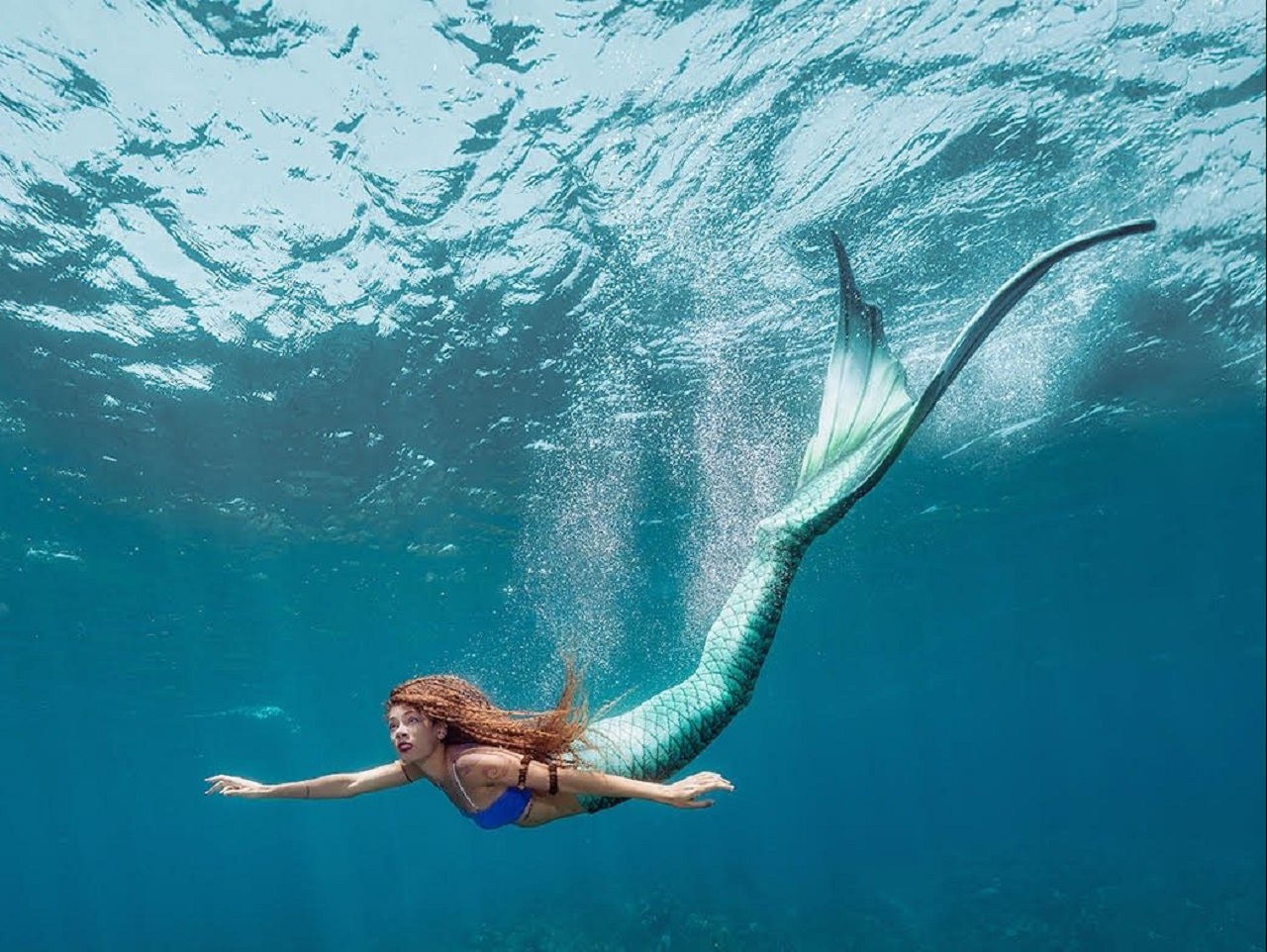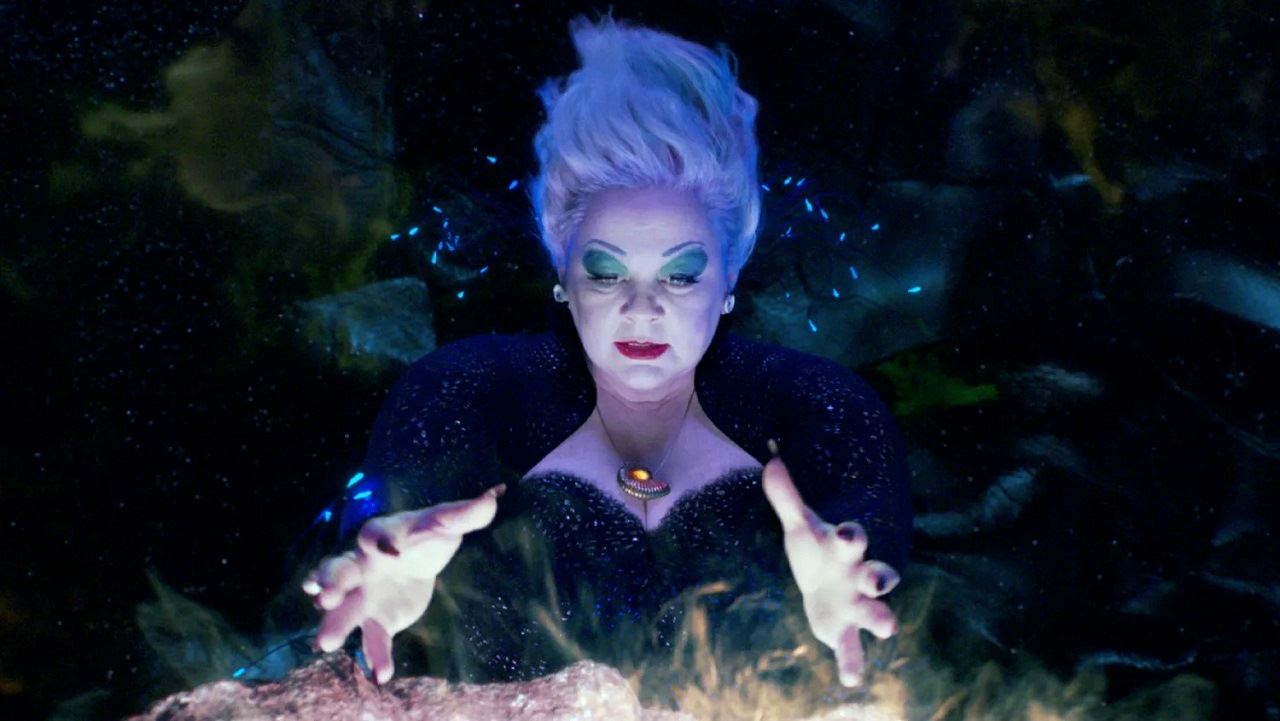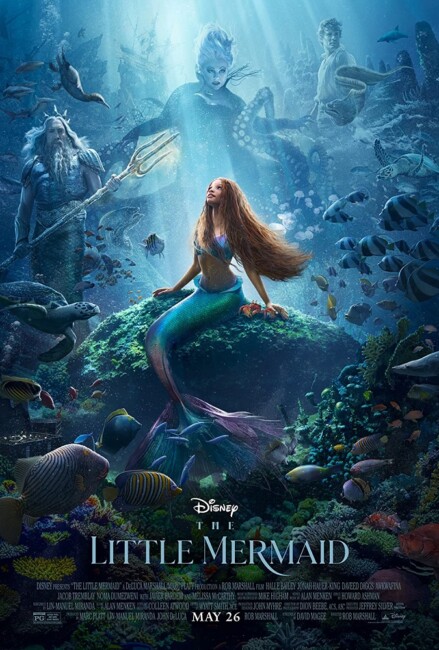USA. 2023.
Crew
Director – Rob Marshall, Screenplay – David Magee, Based on the Film The Little Mermaid (1989) Written by Ron Clements & John Musker, Based on the Fairytale by Hans Christian Andersen, Producers – John DeLuca, Rob Marshall, Lin-Manuel Miranda & Marc Platt, Photography – Dion Beebe, Music – Alan Menken, Songs – (Music) Alan Menken, (Lyrics) – Howard Ashman, (New Lyrics) – Lin-Manuel Miranda, Visual Effects Supervisor – Tim Burke, Visual Effects – Framestore (Supervisor – Andy Kind), MPC (Supervisor – Patrick Ledda), Rodeo FX (Supervisor – Pier Lefebvre), Secret Lab (Supervisors – Olcun Tan & Hoyt H. Yeatman Jr.), Union VFX (Supervisor – Dillan Nicholls), Vitality Visual Effects (Supervisor – Jiwoong Kim), Special Effects Supervisor – Steve Warner, Production Design – John Myhre, Choreographer – Joey Pizzi. Production Company – Disney.
Cast
Halle Bailey (Ariel), Jonah Hauer-King (Prince Eric), Melissa McCarthy (Ursula), Javier Bardem (King Triton), Art Mailk (Sir Grimsby), Noma Dumezweni (The Queen), Jessica Alexander (Vanessa), Martina Laird (Lashana), Emily Coates (Rosa), Lorena Andrea (Perla), Simone Ashley (Indira), Karolina Conchet (Mala), Sienna King (Tamika), Kajsa Mohammar (Karina), Nathalie Sorrell (Caspia)
Voices
Daveed Diggs (Sebastian), Awkwafina (Scuttle), Jacob Tremblay (Flounder)
Plot
Ariel is a mermaid, the daughter of Triton, the king of the seas. Ariel is forbidden from visiting the surface world but looks up at it in fascination, while keeping a secret grotto of artefacts that have fallen into the water. She sneaks up and observes the ship aboard which Prince Eric travels. After a storm sinks the ship, she rescues Eric and takes him ashore. Coming around, he marvels at the mystery woman he only partially glimpsed. Upon finding out what happened, Triton angrily forbids Ariel from seeing Eric again. Ariel is then visited by Triton’s sister Ursula, a witch who offers her the opportunity to be with Eric and casts a spell that transforms Ariel’s tail into legs. However, the price of this is that Ursula takes Ariel’s voice and that Ariel must receive the kiss of true love from Eric within three days or the change is permanent. On land, Ariel is found and taken in at the palace with Eric not realising that she is the mystery girl he is searching for. As attraction grows between Eric and the unworldwise Ariel, Ursula seeks to sabotage it.
The Little Mermaid (1989), liberally adapted from the Hans Christian Andersen fairytale, was the 28th Disney animated film and has become regarded as a modern classic. It was the film that broke the slump that Disney had been in between Walt Disney’s death in 1966 after which the studio’s production of animated films had slowed to one every 3-4 years and was superseded by their output live-action comedies. Part of this came with the ousting of Walt Disney’s son-in-law Ron Miller as CEO in 1984 and replacement with Michael Eisner and the latter’s determination to bring back the Disney animation tradition. This ushered in a new golden era filled with classics such as Beauty and the Beast (1991), Aladdin (1992), The Lion King (1994), Pocahontas (1995), The Hunchback of Notre Dame (1996), Mulan (1998) and Tarzan (1999).
In the 2010s, Disney has embarked on a determined campaign of recycling their animated films in a series of live-action remakes. The trend began with the success of the Tim Burton Alice in Wonderland (2010) and was followed by a series of other remakes and revivals including Maleficent (2014), Cinderella (2015), The Jungle Book (2016), Beauty and the Beast (2017), Aladdin (2019), Dumbo (2019), Lady and the Tramp (2019), The Lion King (2019), Mulan (2020), Cruella (2021), Pinocchio (2022), Peter Pan and Wendy (2023), Lilo & Stitch (2025) and Snow White (2025).
Although in truth, Disney had begun the process of remaking their films back in the 1990s with live-action remakes of classic animated works such as The Jungle Book (1994) and 101 Dalmatians (1996), plus various remakes of their live-action films with Flubber (1997), The Parent Trap (1998), Freaky Friday (2003), Herbie: Fully Loaded (2005), The Shaggy Dog (2006), Race to Witch Mountain (2009) and Tron Legacy (2010).
Director Rob Marshall emerged as a Broadway choreographer in the 1980s where he won Tony awards for his work on shows such as Kiss of the Spider Woman, Damn Yankees and Cabaret. He became a film director with the adaptation of the musical Chicago (2002) and went on to the film adaptations of the musicals Nine (2009) and Into the Woods (2014), along with regular dramatic works like Memoirs of a Geisha (2005). He first joined Disney with Pirates of the Caribbean: On Stranger Tides (2011) and then went on to one of their other revivals with Mary Poppins Returns (2018), which first saw him paired with Lin-Manuel Miranda.

There was much controversy with the announcement of the casting of African-American Halle Bailey as Ariel, resulting in a racial backlash, including the implementation of the #notmyariel Twitter tag. I don’t wish to become embroiled in the debate. And to be fair, Halle Bailey is not too bad as Ariel. She has just the right degree of naiveté and innocence in the early scenes that you can believably accept her as someone from outside looking longingly in on humans. Where she is required to play mute and engage in the romance, Bailey has an infectious sparkle, although seems a little too quiet when it comes to filling the romantic scenes with much passion. The major complaint about Bailey might be that we no longer have an Ariel with distinctive scarlet red hair and that this has been replaced by dreadlocks that render her red hair as auburn.
I am not a fan of the modern Disney live-action remakes. The problem for me is this that is amounts to no more than tableau vivants – a novelty dating from the Victorian era where famous artworks are staged in live-action using actors. These are the filmed equivalents that give animated works the live-action treatment – see Animation in Live-Action. Most of these end up being essentially replicative works that slavishly duplicate each beat of the original. The effect is like a cover band conducting a belaboured rendition of a beloved original song. This is most evident here during the Under de Sea number. In the original, this was a standout sequence that came with an enormous natural energy with Ariel and Sebastian dancing with shoals of fish and the marine life in the area as a chorus line. When Rob Marshall tries to replicate that here, the natural lightness of the cartoon version is replaced by pedestrian choreography and the need to give the fish pseudo-physics in CGI, while the whole song feels like it takes place at half the speed and with little of the energy that the original did.
The colour palette of the original was enormously vibrant – the feeling that the animators were using all the colours in their paint box because they could. For reasons unclear, Marshall reduces much of the look of the film to something dark and murky. The underwater scenes often look as though the lighting in the room had been turned down to bedside lamp levels. This is particularly noticeable when it comes to Ursula’s cave where it is so dark that Marshall gives her glowing tentacles, jetting volcanic vents and has her spill different coloured potions simply in order to add some light to the scene. Certainly, the aboveground scenes are more brightly lit but you only wish that some of the primary colours of the original had used rather than everything rendered in muted pastels.

At 2 hours and 12 minutes, the remake runs nearly three-quarters of an hour longer than the original. Given that it follows the plot of the 1989 film closely, I kept wondering where all of the extra running time came from. Lin-Manuel Miranda adds three unmemorable new songs. There appears to be slightly more when it comes to the romantic scenes with Ariel and Eric, including slapstick scenes in the marketplace and with them running around on a dogcart. There are also more scenes aboard the ship at the start – in the original, Ariel watching on and the shipwreck all occur within the same scene, whereas this draws it out over several scenes.
What I do admire The Little Mermaid for is that it is a seamless integration of live-action and CGI effect. When you are watching Halle Bailey or Javier Bardem swim with tails it is obviously CGI generated but when the film moves into closeup up you are wondering how much of the set around the actors is real or artificially generated. The film moves back and forward between real and artificial with such an effortless ease that any sense of a dividing line no longer exists.
On the other hand, what you have is a prosaic and plodding live-action version of the 1989 film that seems missing in all of its sparkle and natural energy. This is maybe okay for younger audiences unfamiliar with the original. The rest is just a tableau vivants for adult audiences who have seen the original. Me, I have spent too much time on the Disney merry-go-round watching endlessly rehashed IP. I want someone in the organisation to discover the same freshness and originality of the 1990s golden age of animation that produced the original The Little Mermaid and the other abovementioned titles. It was done once, there is no reason it cannot be a second time – all it requires is that the company allow its creative talent to go out on a limb.
Trailer here


